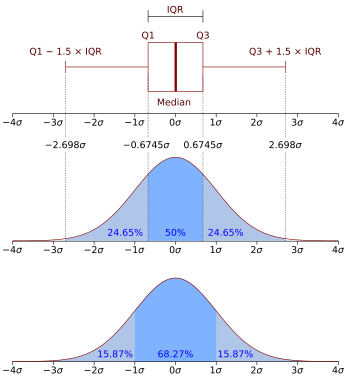
Back دالة الكثافة الاحتمالية Arabic Función de densidá de probabilidá AST Шчыльнасць імавернасці Byelorussian Плътност на вероятността Bulgarian Funció de densitat de probabilitat Catalan Hustota pravděpodobnosti Czech Пулаяслăх йăвăлăхĕ CV Sandsynlighedstæthedsfunktion Danish Wahrscheinlichkeitsdichtefunktion German Συνάρτηση πυκνότητας πιθανότητας Greek
This article needs additional citations for verification. (June 2022) |


In probability theory, a probability density function (PDF), density function, or density of an absolutely continuous random variable, is a function whose value at any given sample (or point) in the sample space (the set of possible values taken by the random variable) can be interpreted as providing a relative likelihood that the value of the random variable would be equal to that sample.[2][3] Probability density is the probability per unit length, in other words, while the absolute likelihood for a continuous random variable to take on any particular value is 0 (since there is an infinite set of possible values to begin with), the value of the PDF at two different samples can be used to infer, in any particular draw of the random variable, how much more likely it is that the random variable would be close to one sample compared to the other sample.
More precisely, the PDF is used to specify the probability of the random variable falling within a particular range of values, as opposed to taking on any one value. This probability is given by the integral of this variable's PDF over that range—that is, it is given by the area under the density function but above the horizontal axis and between the lowest and greatest values of the range. The probability density function is nonnegative everywhere, and the area under the entire curve is equal to 1.
The terms probability distribution function and probability function have also sometimes been used to denote the probability density function. However, this use is not standard among probabilists and statisticians. In other sources, "probability distribution function" may be used when the probability distribution is defined as a function over general sets of values or it may refer to the cumulative distribution function, or it may be a probability mass function (PMF) rather than the density. "Density function" itself is also used for the probability mass function, leading to further confusion.[4] In general though, the PMF is used in the context of discrete random variables (random variables that take values on a countable set), while the PDF is used in the context of continuous random variables.
- ^ "AP Statistics Review - Density Curves and the Normal Distributions". Archived from the original on 2 April 2015. Retrieved 16 March 2015.
- ^ Grinstead, Charles M.; Snell, J. Laurie (2009). "Conditional Probability - Discrete Conditional" (PDF). Grinstead & Snell's Introduction to Probability. Orange Grove Texts. ISBN 978-1616100469. Archived (PDF) from the original on 2003-04-25. Retrieved 2019-07-25.
- ^ "probability - Is a uniformly random number over the real line a valid distribution?". Cross Validated. Retrieved 2021-10-06.
- ^ Ord, J.K. (1972) Families of Frequency Distributions, Griffin. ISBN 0-85264-137-0 (for example, Table 5.1 and Example 5.4)